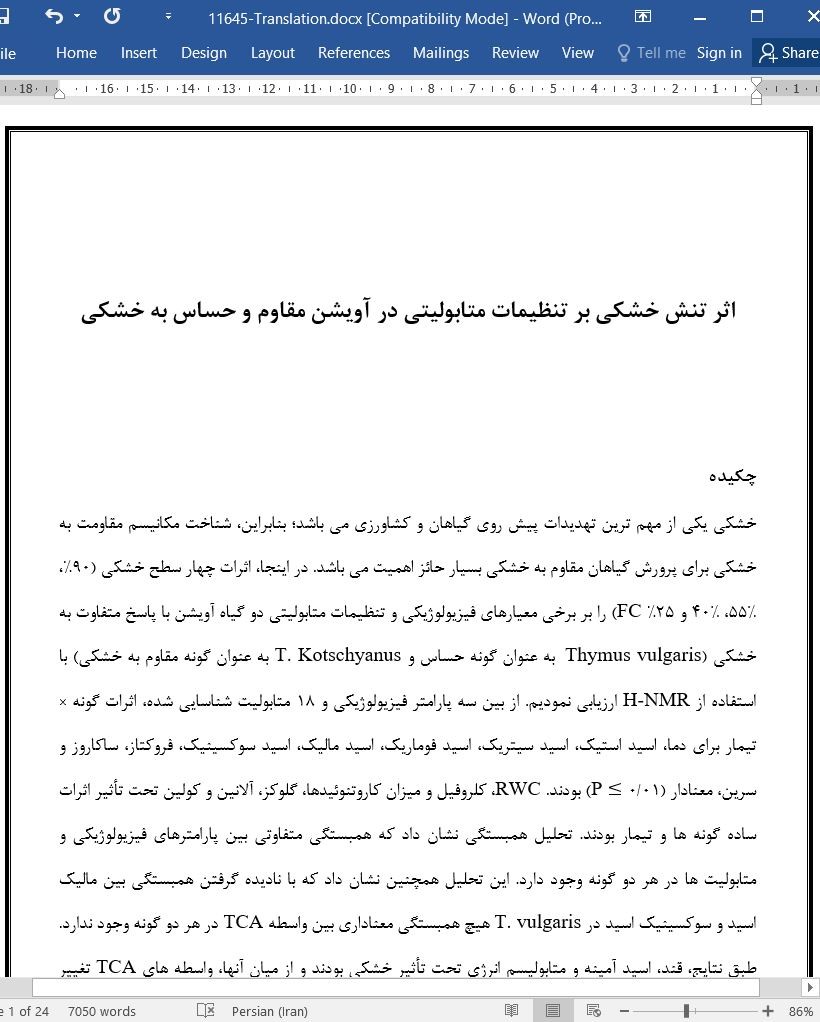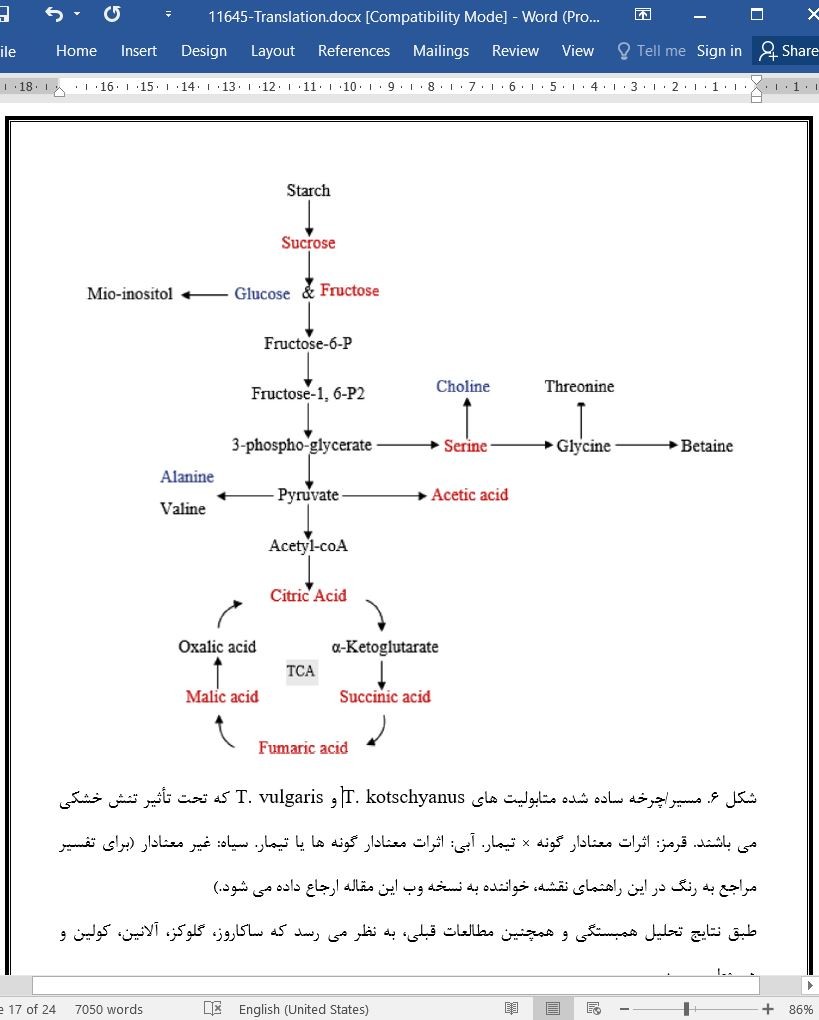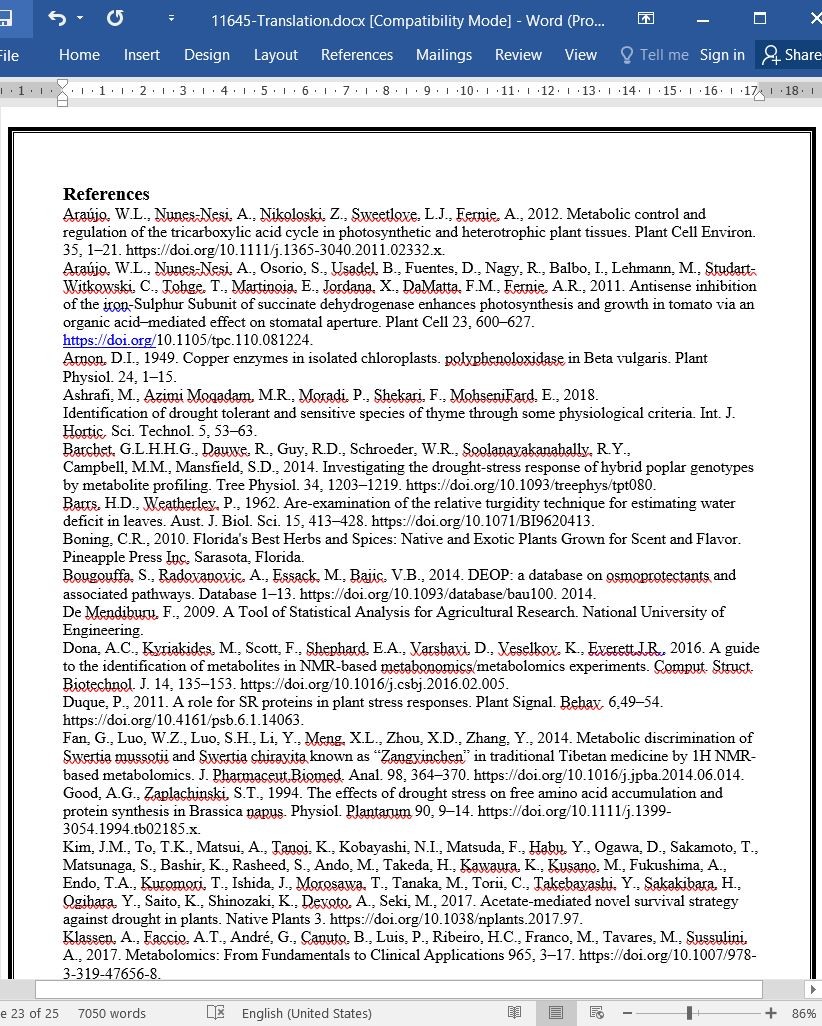
اثر تنش خشکی بر تنظیمات متابولیتی در آویشن مقاوم و حساس به خشکی
چکیده
خشکی یکی از مهم ترین تهدیدات پیش روی گیاهان و کشاورزی می باشد؛ بنابراین، شناخت مکانیسم مقاومت به خشکی برای پرورش گیاهان مقاوم به خشکی بسیار حائز اهمیت می باشد. در اینجا، اثرات چهار سطح خشکی (90%، 55%، 40% و 25% FC) را بر برخی معیارهای فیزیولوژیکی و تنظیمات متابولیتی دو گیاه آویشن با پاسخ متفاوت به خشکی (Thymus vulgaris به عنوان گونه حساس و T. Kotschyanus به عنوان گونه مقاوم به خشکی) با استفاده از H-NMR ارزیابی نمودیم. از بین سه پارامتر فیزیولوژیکی و 18 متابولیت شناسایی شده، اثرات گونه × تیمار برای دما، اسید استیک، اسید سیتریک، اسید فوماریک، اسید مالیک، اسید سوکسینیک، فروکتاز، ساکاروز و سرین، معنادار (01/0 ≤ P) بودند. RWC، کلروفیل و میزان کاروتنوئیدها، گلوکز، آلانین و کولین تحت تأثیر اثرات ساده گونه ها و تیمار بودند. تحلیل همبستگی نشان داد که همبستگی متفاوتی بین پارامترهای فیزیولوژیکی و متابولیت ها در هر دو گونه وجود دارد. این تحلیل همچنین نشان داد که با نادیده گرفتن همبستگی بین مالیک اسید و سوکسینیک اسید در T. vulgaris هیچ همبستگی معناداری بین واسطه TCA در هر دو گونه وجود ندارد. طبق نتایج، قند، اسید آمینه و متابولیسم انرژی تحت تأثیر خشکی بودند و از میان آنها، واسطه های TCA تغییر بیشتری در دو گونه مورد مطالعه داشتند، بنابراین، این چرخه و واسطه های آن احتمالاً نقش برجسته تری نسبت به دیگر متابولیت های شناسایی شده در ایجاد مقاومت خشکی دارند.
1. مقدمه
تنش های محیطی (تنش زیستی و غیرزیستی)، تهدیدهایی جدی برای تولید کشاورزی به حساب می آیند (ناکابایاشی و سایتو، 2015). خشکی یک عامل تنش زای زیست محیطی غیرزیستی برای گیاهان بوده و کمبود آب معمولاً محدود کننده ترین عامل برای رشد، عملکرد و ثمردهی گیاهان به شمار می رود (بارچت و همکاران، 2014). در اکثر مناطق دنیا، کشاورزی بیشتر تحت تأثیر خشکی است که علت آن تغییرات در الگوی بارندگی ناشی از تغییر اقلیم جهانی و همینطور رقابت با جمعیت و صنعت درحال رشد می باشد (سانچز و همکاران، 2012). برای افزایش بهره وری کشاورزی در منابع ناکافی زمین، اطمینان از عملکرد بالاتر محصول درمقابل تنش های زیست محیطی نامطلوب حائز اهمیت می باشد. شناخت واکنش گیاهان به شرایط محدودیت آب، ضروری است و مسیر بهبود مقاومت نسبت به خشکی را هموار می سازد (ردی و همکاران، 2004).
Abstract
Drought is one of the most important threats to plants and agriculture; therefore, understanding of the mechanism of drought tolerance is crucial for breeding of drought tolerant plants. Here, we assessed effects of four levels of drought (90%, 55%, 40% and 25% FC) on some physiological criteria and metabolite adjustment of two different drought-responsive thyme plants (Thymus vulgaris as drought sensitive and T. Kotschyanus as drought tolerant species), using 1H-NMR. Among three physiological parameters and 18 identified metabolites, species × treatment effects were significant (P ≤ 0.01) for leaf temperature, acetic acid, citric acid, fumaric acid, malic acid, succinic acid, fructose, sucrose and serine. RWC, chlorophyll and carotenoids content, glucose, alanine and choline were affected by simple effects of species and treatment. Correlation analysis revealed that there is a different correlation between physiological parameters and metabolites in both species. This analysis also revealed that, by ignoring the correlation between malic acid and succinic acid in T. vulgaris, there was no significant correlation between TCA intermediate in both species. According to results, sugars, amino acid and energy metabolism were affected by drought and, among them, TCA intermediates had more alternation in two studied species so, this cycle and its intermediates probably have more prominent role than other identified metabolites in the induction of drought tolerance.
1. Introduction
Environmental stresses (biotic and abiotic stress) are serious threats to agricultural production (Nakabayashi and Saito, 2015). Drought is an important abiotic environmental stressor of plants and water deficit is typically the most limiting factor for plant growth, yield, and productivity (Barchet et al., 2014). In most areas of the world, agriculture is more influenced by drought because of changes in rainfall pattern caused by global climate change, as well as competition with growing population and industry (Sanchez et al., 2012). To increase the agricultural efficiency within the inadequate land resources, it is important to ensure higher crop yields against unfavorable environmental stresses. Understanding the reaction of plants to water-limited conditions is crucial and will pave the way for improving tolerance to drought (Reddy et al., 2004).
چکیده
1. مقدمه
2. مواد و روش ها
1.2. مواد گیاهی، شرایط رشد و تیمار
2.2. اندازه گیری های فیزیولوژیکی
3.2. استخراج متابولیت و طیف بینی NMR
4.2. پایگاه های داده و نرم افزار برای شناسایی متابولیت
5.2. H NMR کمی
6.2. طرح آزمایش و تحلیل آماری
3. نتایج
1.3. اندازه گیری های فیزیولوژیکی
2.3. شناسایی متابولیت
3.3. تحلیل آماری
4.3. اثرات تیمار خشکی بر غلظت متابولیت ها
5.3. مسیر/چرخه متابولیکی تحت تأثیر خشکی و تحلیل همبستگی
4. بحث
5. نتیجه گیری
ABSTRACT
1. Introduction
2. Materials and methods
2.1. Plant material, growth condition, and treatment
2.2. Physiological measurements
2.3. Metabolite extraction and NMR spectroscopy
2.4. Databases and software for metabolite identification
2.5. Quantitative H NMR
2.6. Experimental design and statistical analysis
3. Results
3.1. Physiological measurements
3.2. Metabolite identification
3.3. Statistical analysis
3.4. Effects of drought treatment on metabolites concentration
3.5. Metabolic pathway/cycle affected by drought and correlation analysis
4. Discussion
5. Conclusion
- اصل مقاله انگلیسی با فرمت ورد (word) با قابلیت ویرایش
- ترجمه فارسی مقاله با فرمت ورد (word) با قابلیت ویرایش، بدون آرم سایت ای ترجمه
- ترجمه فارسی مقاله با فرمت pdf، بدون آرم سایت ای ترجمه



